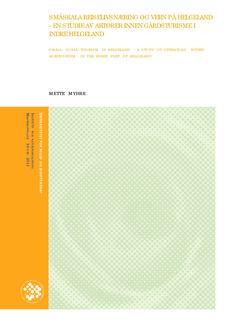| dc.description.abstract | Denne masteroppgaven er en studie av aktører innen gårdsturisme i indre Helgeland i Nordland fylke. Ettersom denne oppgaven i utgangspunktet skulle være tilknyttet prosjektet Tool for Sustainability Impact Assessment (ToSIA) var case- område allerede bestemt.
Formålet med denne studien var å finne svar på følgende: (1) Hvordan har utviklingen av verneområdene på Helgeland påvirket driften av reiselivsnæringen i indre Helgeland? og (2) Hvordan kan aktørene innen gårdsturisme i indre Helgeland bygge opp seg selv som attraksjon i tråd med Innovasjon Norge sine prinsipper for et bærekraftig reiseliv, spesielt innen økonomisk levedyktighet?
Dette ble undersøkt blant annet gjennom teori om bærekraftig reiseliv, attraksjonsutvikling og reiselivets paradoks. Analyser ble foretatt etter dybdeintervju med åtte ulike respondenter fra de fire kommunene; Vefsn, Grane, Hattfjelldal og Hemnes.
Etter gjennomført analyse av innsamlet data satt jeg igjen med fire kategorier (samarbeid, personlige hensikter, holdninger og bærekraftig attraksjon) som bidro til å svare på problemstillingene. Samarbeidskategorien er knyttet til det jeg tolker som respondentenes ønske om bedre samarbeid. Kategorien personlige hensikter er personavhengig og vil dermed variere fra person til person. Respondentenes personlige hensikter påvirker både hvordan de forholder seg til verneutviklingen, samt hvordan de ser for seg en attraksjonsutvikling av egen bedrift. Holdningskategorien sier noe om forholdet mellom hvordan respondenten ser på vernet og hvilken betydning verneutviklingen har for respondentene som reiselivsaktører. Kategorien bærekraftig attraksjon knyttes til blant annet respondentenes egen definisjon av de to begrepene, og er spesielt viktig for å kartlegge hva respondentene selv legger i begrepene.
Denne undersøkelsen viser at verneutviklingen på Helgeland har hatt liten eller ingen påvirkning på aktørene innen gårdsturisme i indre Helgeland. Samtidig viser den også at det er behov for bedre samarbeid, både horisontalt mellom aktørene og vertikalt mellom aktørene og kommune/ fylket, dersom de samme aktørene skal få til en bærekraftig attraksjonsutvikling knyttet til økonomisk levedyktighet.
This master thesis is based on a study of operators within agritourism in the inner part of
Helgeland in Nordland County, Northern Norway. The precinct of this thesis was already
decided from the project Tool for Sustainability Impact Assessment (ToSIA).
The aim of this study was to answer the following questions: (1) how has the development
of protected areas in Helgeland affected the tourism industry in the inner part of
Helgeland? and (2) how can the operators within agritourism in the inner part of
Helgeland develop their own business as an attraction affiliated with Innovation
Norway’s principles for sustainable tourism, especially connected to economic viability?
This was examined through theory of sustainable tourism, attraction development, and the
paradox of tourism. Analyses were made after interviewing eight respondents in the four
municipalities; Vefsn, Grane, Hattfjelldal and Hemnes.
Analyzing the assembled primary data resulted in four categories: cooperation, personal
intentions, attitudes and sustainable attraction. These four categories helped me to answer the
research questions. The cooperation category is related to what I interpret as the respondents
wish for better cooperation. The personal intentions category is person- dependent and will
vary from person to person. The respondent’s personal intentions will affect their relation to
the development of protected areas, as well as what they think of an attraction development of
their own business. Further, the category of attitudes tells us something about the relation
between the respondent’s bond to protected areas (positive/ negative) and the importance of
development of these areas to the tourism operators. The sustainable attraction category is
linked to the respondent’s own definition of the two terms and is especially important to
determine what the respondent thinks of these two concepts.
After this study I can conclude that the development of protected areas in Helgeland have had
a small or no affect on the operators within agritourism in the inner part of Helgeland.
Simultaneously, the study indicates a need for better cooperation both between the operators,
as well as between the operators and the municipalities and Nordland County. | en_US |
